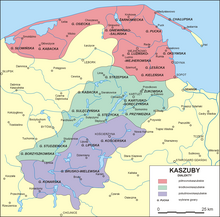Slowinzen


The Slovins or Slovinzes ( Kashubian Słowińcë , Polish Słowińcy ) were a West Slavic people who lived in the Slovinian coastal region in Western Pomerania . Their settlement area was roughly between the cities of Stolp ( Słupsk ) and Leba ( Łeba ), today part of the Polish Pomeranian Voivodeship .
They called themselves Kashubs . The names Slowinzen and Leba kaschuben are xenonyms that are not of German origin, but were introduced by Germans: Karl Gottlob von Anton , Provost AT Kummer from Groß Garde (1835) and Provost Gottlieb Leberecht Lorek . Alexander Fjodorowitsch Hilferding used the name Slowinzen to describe the smaller part of The Remains of the Slavs on the south side of the Baltic Sea . That is why many German scholars considered the term Slovince to be a pan-Slavic fraud, with the exception of Friedrich Lorentz . Polish scientists only supported this attitude from 1990 onwards. Nowadays only a few Polish scholars consider the name Slowinzen to be older than it was in the 18th century.
The Slovinces differed from the Catholic Kashubians living in Pomerania in that they were Protestant . Unlike the Catholic Kashubians, many Slovins already adopted the German language from the middle of the 17th to the 18th century , when the use of the Kashubian language was pushed back by assimilation. During the census of 1858, fewer than 450 people were identified in eastern Pomerania who still referred to themselves as Kashubians, while 4880 people spoke the Kashubian language. Since the Kashubians had increasingly adopted the German language, it was no longer absolutely necessary, for example, to hold confirmation classes and church services in the Kashubian language. However, the abolition was occasionally seen as a hardship, especially among older people. In addition to numerous field names , a few words in the local Pomeranian everyday German testified to the Slavic origin of the Slovins .
When in 1945/46 the Pomeranians, unless they had already fled from the Red Army , were expelled due to the Bierut decrees , the villagers, whose mother tongue was the Slovenian language , were fundamentally exempt. In some cases, people were allowed to stay who did not speak Slovincian themselves, but could prove their Slovinian origin. Many of the pre-war residents lived in the area in the 1950s and a few in the 1980s. The older ones lived in their houses until the end of their lives, many of the younger ones emigrated at some point.
The Slowinski National Park (Słowiński Park Narodowy) is named after the Slowins. Part of the national park is the open-air museum of the Slowinese village in Kluki , in which the life of the Slowinese is documented. Incidentally, one of the outstanding features of the Slovene houses is the visible half-timbering, closer to German building tradition than Polish. The Slovenian language has disappeared today. The establishment and naming of the national park in the vicinity of the Leba sand dunes as well as the establishment of the open-air museum Slowinzisches Dorf took place after the annexation of Western Pomerania to Poland in 1945. The naming after the Slovins is also to be seen in the context of Polish historical politics of the 1960s. The memory of a West Slavic ethnic group was intended to historically legitimize the Polish claim to East Pomerania, which in 1945 was almost exclusively inhabited by Germans (see German Eastern Territories ).
See also
- Nehrungskurisch : East Baltic-Latvian dialect or language from the Curonian Spit, whose last speakers also fled in 1944/45 and of whom only a few, old speakers lived in Germany at the beginning of the 21st century
Web links
- Ewa Rzetelska-Feleszko: Slowinzisch . (with information about the speakers in the beginning and middle of the 20th century).
- Slowincian open-air museum Kluki / Klucken
- Klucken - home of the Lebakaschubes , about today's museum village and its last previous inhabitants.
Individual evidence
- ↑ J. Koblischke: The name "Slovinzen" . "Communications of the Association for Kashubian Folklore" 1908; O. Knoop: Something from the Kashubians . "Our home" 1925; Z. Szultka: Studia nad rodowodem i językiem Kaszubów. 1992; M. Filip: Od Kaszubów do Niemców. Tożsamość Slowińców z perspektywy antropologii historii. 2012
- ^ KG von Anton: First lines of an attempt on the ancient Slavs origins, customs, customs, opinions and knowledge. 1783, p. 22
- ↑ s. Z. Szultka: Studia nad rodowodem i językiem Kaszubów. 1992
- ^ GL Lorek: On the characteristics of the cash boxes on the Leba river. Treptow 1820/1821
- ↑ AF Hilferding: The remains of the Slavs on the south side of the Baltic Sea . In: Journal of Slavic Literature, Art and Science . Volume I, Issue 1, Bautzen 1862, pp. 81–97 ( full text ), Volume I, Issue 4, Bautzen 1864, pp. 230-230 ( full text) and Volume II, Issue 2, Bautzen 1864, pp. 81–111 ( Full text. )
- ↑ J. Koblischke: The name "Slovinzen". "Messages of the Association for Kashubian Folklore" 1908
- ↑ O. Knoop: Something about the Kashubians. "Our home" 1925
- ↑ F. Kluge: A Kashubian image that has changed many times. Recent Polish research on Kashubia and its inhabitants. In: Zeitschrift für Ostforschung 43 (1994), pp. 71–81, see also M. Filip: Od Kaszubów do Niemców. Tożsamość Słowińców z perspektywy antropologii historii. 2012
- ↑ J. Treder: Komu może przeszkadzać etnonim Słowińcy? In: A. Czarnik (ed.): Obrazy Ziemi Słupskiej. 2003
- ^ Friedrich Wilhelm Hermann Wagener: State and Society Lexicon . 1st volume, Berlin 1862, p. 170 .
- ↑ BA Hilferding: The remains of the Slavs on the south coast of the Baltic Sea . In: Journal for Slavic Literature, Art and Science , Volume 1, Issue 2, Bautzen 1862, pp. 81–97 .
- ↑ Stanisław Dubisz: Dialekty i gwary polskie. Warszawa: "Wiedza Powszechna", 1995, p. 32 ff.
